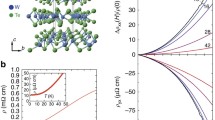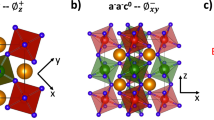Abstract
Abstract
The unique diffusion mechanism in the novel polyatomic anion conductor scandium tungstate is studied by molecular dynamics simulations of systems with artificially induced WO4 2− defects and compared to our previous simulations of defect-free structure models. The diffusion activation energy obtained from structures with built-in defects is smaller than for the defect-free models and in the case of tungstate vacancies close to the experimental value, suggesting that extrinsic tungstate vacancies due to the volatility of WO3 are important for the experimental conductivity. The validity of the force field used for the molecular dynamics simulations is further verified by investigating the orthorhombic to monoclinic phase transition of Sc2(WO4)3 under compression. The lattice compressibility in both phases and the phase transition is qualitatively reproduced, though the simulated phase transition pressure occurred is about 0.55 GPa higher than the experimental one.
Graphical abstract








Similar content being viewed by others
References
Imanaka N, Kobayashi Y, Adachi GY (1995) Chem Lett 24:433−434
Imanaka N, Kobayashi Y, Fujiwara K, Asano T, Okazaki Y, Adachi GY (1998) Chem Mater 10:2006−2012
Köhler J, Imanaka N, Adachi G (1999) Z Anorg Allg Chem 625:1890−1896
Köhler J, Imanaka N, Adachi GY (1999) J Mater Chem 9:1357−1362
Kobayashi Y, Egawa T, Tamura S, Imanaka N, Adachi GY (1997) Chem Mater 9:1649−1654
Kobayashi Y, Egawa T, Okazaki Y, Tamura S, Imanaka I, Adachi G (1998) Solid State Ion 111:59−65
Tamura S, Egawa T, Okazaki Y, Kobayashi Y, Imanaka N, Adachi G (1998) Chem Mater 10:1958−1962
Adachi G, Köhler J, Imanaka N (1999) Electrochemistry 67:744−751
Imanaka N, Kobayashi Y, Tamura S, Adachi G (2000) Solid State Ion 136:319−324
Kulikova T, Neiman A, Kartavtseva A, Edwards D, Adams S (2008) Solid State Ion 178:1714−1718
Driscoll DJ, Islam MS, Slater PR (2005) Solid State Ion 176:539−546
Evans JSO, Mary TA, Sleight AW (1998) J Solid State Chem 137:148−160
Evans JSO (1999) J Chem Soc Dalton 3317−3326
Evans JSO, Mary TA, Sleight AW (1997) J Solid State Chem 133:580−583
Forster PM, Yokochi A, Sleight AW (1998) J Solid State Chem 140:157−158
Sumithra S, Tyagi AK, Umarji AM (2005) Mater Sci Eng B 116:14−18
Zhou YK, Adams S, Rao RP, Edwards DD, Neiman A, Pestereva N (2008) Chem Mater 20:6335−6345
Andersen NH, Bandaranayake P, Careem MA, Dissanayake M, Wijayasekera CN, Kaber R, Lunden A, Mellander BE, Nilsson L, Thomas JO (1992) Solid State Ion 57:203−209
Jansen M (1991) Angew Chem Int Ed Engl 30:1547−1558
Lunden A (1988) Solid State Commun 65:1237−1240
Varga T, Wilkinson AP, Jorgensen JD, Short S (2006) Solid State Sci 8:289−295
Garg N, Murli C, Tyagi AK, Sharma SM (2005) Phys Rev B 72. Art. No. 064106
Laaksonen L (1992) J Mol Graph 10:33−34
Materials Studio, version 4.2 (2007) Accelrys Inc., San Diego
Cerius2, version 4.9 (2003) Accelrys Inc., San Diego
Acknowledgments
Financial support by A-Star SERC to the Materials World network project no. 062 119 0009 is gratefully acknowledged.
Author information
Authors and Affiliations
Corresponding author
Rights and permissions
About this article
Cite this article
Zhou, Y., Prasada Rao, R. & Adams, S. Mechanism of defect formation and polyanion transport in solid scandium tungstate type oxides. Monatsh Chem 140, 1017–1023 (2009). https://doi.org/10.1007/s00706-009-0140-8
Received:
Accepted:
Published:
Issue Date:
DOI: https://doi.org/10.1007/s00706-009-0140-8




